The changing climate and the risks it presents for global organizations is moving up the agenda in boardrooms around the world. A growing number of organizations are already experiencing impacts in their supply chains, infrastructure, employee health, and operations. The need for adaptation is no longer an abstract notion, but rather one that involves making rigorously considered changes in order to remain competitive. Tracking progress on adaptation, however, is no easy task, and for many business leaders, this is still a relatively new area.
In 2024, Marsh launched its Corporate Climate Adaptation Survey with the aim of understanding how adaptation is considered by private-sector organizations, and how this perspective is informed by the risk manager. The research provides unique insight, unpacking corporate adaptation through the eyes of those tasked with developing and implementing strategies.
1. Increasing physical climate risks have financial impacts on organizations
It is clear from the research that organizations are already feeling the financial impacts of increasing physical climate risks: 50% of respondents reported they had suffered from extreme weather events in the past three years. Tropical storms (typhoons, hurricanes, and cyclones) and river flooding caused the greatest impact.
The question of how to respond has emphatically reached corporate decision makers: 83% said that they were considering the impacts of climate physical risk or have conducted some form of climate risk assessment to improve their understanding.
The survey also confirms that for organizations, climate hazards pose a threat well beyond physical assets. Participants experienced impacts on their operations and people (33% of respondents); supply chains (20%); customers (20%); critical infrastructure (20%) and local communities (14%).
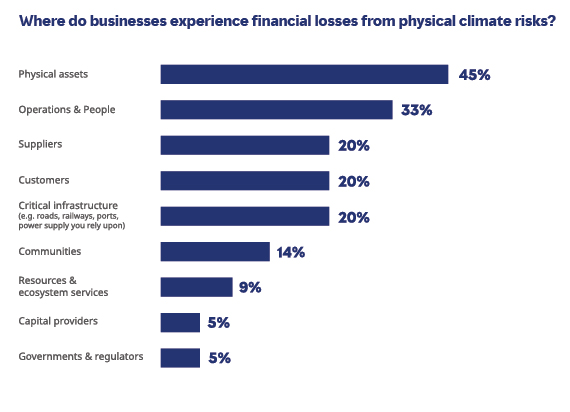
Source: Marsh
2. Risk managers implement a range of measures to adapt to climate risks
The survey reveals that corporates have started taking action in response to the growing physical risks. Three of the largest areas of focus are business continuity planning and testing (49%), investing in asset engineering to better withstand extreme events without downtime (41%) and adapting working patterns (33%).
In terms of future risks, organizations see the need for more investment in asset engineering to improving recovery time(s) from extreme weather events (24%) and to better withstand extreme weather events (20%). A third of companies (32%) saw investing in business continuity planning and testing as important for the future.
Engagement with others
The survey also highlights that business leaders are engaging with external stakeholders as they manage the impacts of climate change. With 90% of respondents confirming they have discussed climate adaptation with outside partners, the results show a healthy spread across a number of key stakeholders. Their most significant engagement was with industry partners (49%), the public sector (42%) and regulators (38%).
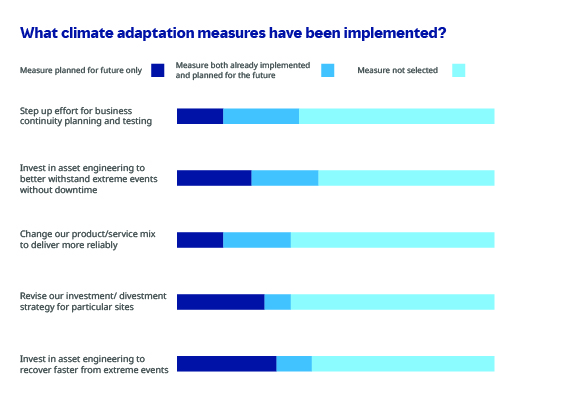
Source: Marsh
3. Operationalizing adaptation is a challenge without a full understanding of climate risk
In addition to providing a picture of how businesses are considering adaptation, the survey also shines a light on some of the challenges. These include ‘blind spots’ in the way companies understand climate risk, as well as some uncertainty around how to go about operationalizing adaptation:
Lack of quantitative assessments. While more than 8 in 10 business leaders are analyzing their climate risk (83%), nearly half (48%) revealed that they are currently only performing qualitative analyses.
Limited understanding of system-level risks. While there is generally good alignment between business areas impacted by losses and those considered as part of risk assessment, many system-level considerations — including suppliers (30%), governments & regulators (29%), resources & ecosystem services (21%), and capital providers (13%) — are still only assessed by a minority of respondents.
An issue for the future, not for now? Our research suggests that many businesses and organizations see climate adaptation as something that will only really be relevant to them in the future.
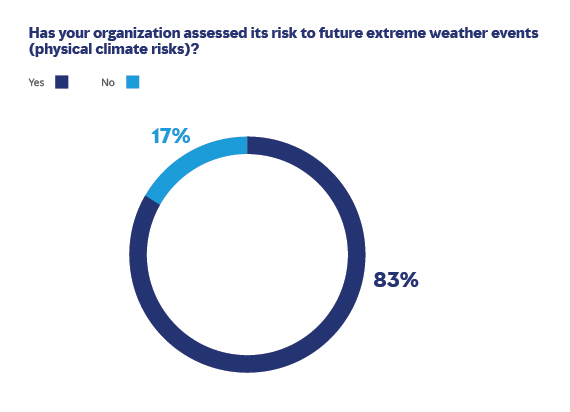
Source: Marsh

Source: Marsh
Businesses aren’t adequately considering the role of nature in adaptation
Another untapped opportunity that emerged in our survey was nature. Although some businesses reported that they were exploring nature-based solutions as part of their climate adaptation, our research suggests that this is an area that could be further leveraged in the future. Nature-based and nature-positive solutions being implemented by survey respondents include:
- Water restoration projects.
- Investments in local biodiversity and native habitats.
- Rainwater harvesting and boreholes to resist water stress.
- Grant-giving in communities where the business operates.
- Incorporating climate projection data into design standards.
- Monitoring and evaluating effectiveness of adaptation actions.
4. Many organizations see adaptation as a cost, not an investment
The data suggests that around 4 in 10 companies (43%) still see adaptation simply as a cost, rather than as a sound investment. This signals the need for better understanding of adaptation as a cost-effective way to build resilience to future risks – as well as creating a more sustainable future.
At the heart of every business is a clear understanding of costs vs. benefits – and this method is vital in determining the business case for climate adaptation. Some 57% of business leaders reported using cost-benefit analyses to demonstrate the business case for adaptation and determine the appropriate strategy.
Making the business case for adaptation
In the survey, some respondents also shed light on the difficulties they have encountered in operationalizing adaptation. Some shared that it remains hard to make risk identification and cost assessment tangible; others have found it challenging to make assumptions and justify the value of investment in adaptation. Other hurdles to overcome included uncertainty related to future climate scenarios, and more specifically, the challenge of building a business case to address a risk that is uncertain or may not eventuate for ten years or more.

Source: Marsh
5. Optimizing the cost of risks with insurance and adaptation strategies
There appears to be a growing recognition that cost of risk optimization require integration of insurance and adaptation strategies: 37% of those who responded to our survey said they are speaking to insurers, and 30% reported speaking to brokers about adaptation. 29% confirmed they are thinking about climate change adaptation and resilience as part of their insurance planning cycle.
In order to provide this support, the insurance industry need to grapple with the complexities of climate change, many of which present unprecedented challenges in assessing feasibility. In some parts of the world, insurance is no longer available, or is becoming unaffordable for some perils. This issue has been highlighted, for example, in the US property market: In Florida, between 2018 and 2022, the number of homeowners turning to the state-backed insurer of last resort, Citizens, more than doubled from less than 450,000 to 1.2 million. In Australia, over 500,000 homes are predicted to become uninsurable by 2030 due to climate change impacts. Investing in adaptation can help build resilience and improve the insurability of underserved communities.
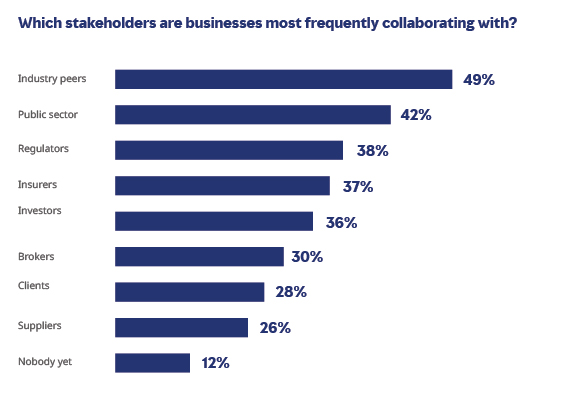
Source: Marsh
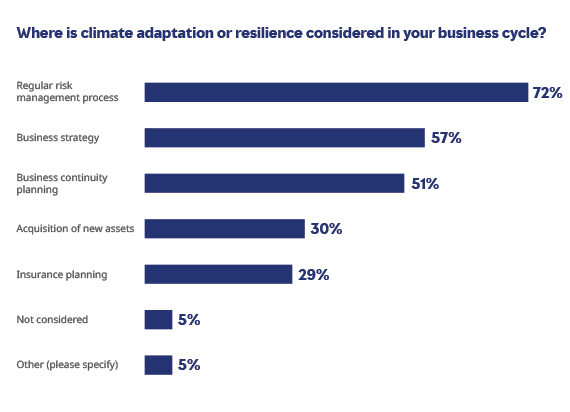
Source: Marsh
6. Adaptation is necessary not only for operations, but also for workforces and communities
As companies seek a greater understanding of their climate-related risk, leaders know that wherever assets and operations may be impacted, people and the communities in which they live may also be severely affected. In our survey, 33% of respondents said they had started adapting working patterns as a way of supporting their employees. As well as safeguarding employees’ wellbeing, such measures can help to protect long-term productivity, and prepare for future legislation designed to protect workers.
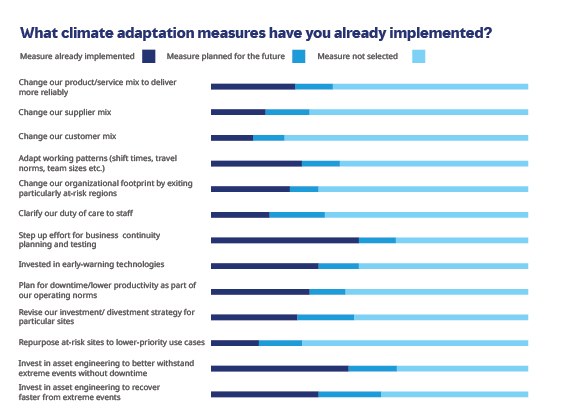
Source: Marsh
Climate upheaval is now widely recognized as a driver of material risk - an unwieldy challenge with potential impacts at every level of an organization. Climate adaptation can help businesses to progress from understanding physical risk, to reducing vulnerabilities, protecting people and assets, and strengthening resilience.
This new research reveals that the climate challenge is a key concern for today’s business leaders, and that companies are considering a climate adaptation approach at the highest level. But many struggle to map and identify complex climate risks; some still see adaptation simply as a cost; and others find it difficult to justify investment to mitigate a risk that is ill-defined or feels distant.
Using a dynamic risk-management approach, companies can improve visibility of physical climate risk across the business and consider the impact on both assets and systems. In the face of uncertainty, an agile climate adaptation strategy allows companies to invest in plans that evolve, safeguarding their people, their operations, and their natural environment for the long-term.
